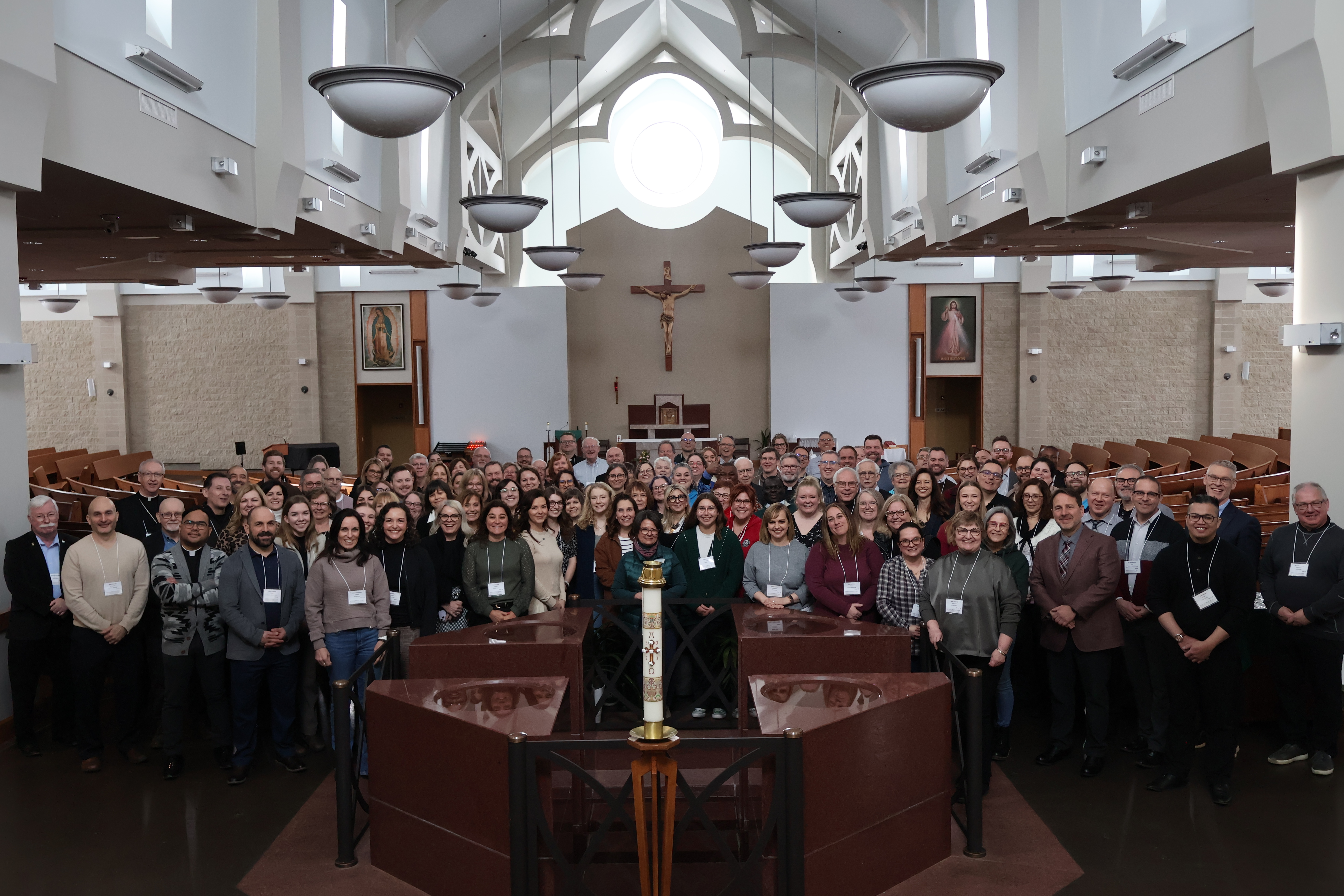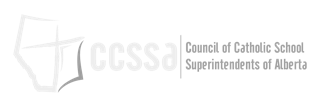This article was originally published in the Spring 2005 issue of The Catholic Dimension, and is re-posted here for public reference.
The first formal European education to reach what is now Alberta arrived with the Catholic missionaries. In 1838, Fathers Blanchet and Demers arrived at Fort Edmonton, in 1842, Father Thibault founded the first Catholic mission at Lac St. Anne and was joined in 1844 by Father Bourassa, who later founded missions at Lesser Slave Lake and Grande Prairie. In 1845, Father de Smet resided in Edmonton while he acted as "peace maker" between the Blackfoot and the Flatheads. These Oblate fathers were joined in 1853 by Father Remas and each were involved in the introduction of Catholic education in what is now Central and Northern Alberta. However, the first missionary to introduce formal schooling was Father Albert Lacombe who arrived at Lac St. Anne in 1852 and immediately began instructing both adults and children.
In 1857, Bishop Tache founded a native school at Lac la Biche, under the control of three Grey Nuns-Sisters Grienette, Daunais and Trisseur. By 1859, three other Grey Nuns, Sisters Leblanc-Emery, Lamy and Jacques-Alphonse, had arrived at Lac St. Anne and the first boarding school, with 42 students, was opened. That allowed Father Lacombe and Father TachŽ to establish a mission in St. Albert in 1861.
The first regular school west of the Red River Colony was established at Fort Edmonton in 1862 by Brother Scollen, soon followed by the normal schools in St. Albert in 1863, under the tutelage of Father Grouard, Brother Alexis and a number of teaching sisters from Lac St. Anne, and in Fort McLeod in 1863.
In the 1860s, the separate school question was a prominent issue in the political debate leading to confederation, which could not have been achieved without the protections granted to separate schools in Section 93 of the Constitution Act, 1867. Section 93 conferred on the provinces the exclusive power to make laws in relation to education. However, it was the D'Arcy McGee amendment of 1864 and the Alexander Galt amendment of 1866, embodied in subsections 1 through 3 of Sections 93, which was recognized by the Supreme Court of Canada in Reference re: Bill 30 as the political compromise, the "solemn pact," "which made confederation possible." As Sir Charles Tupper said in the House of Commons:
" ... without this clause, without this guarantee for the rights of minorities being embodied in that new constitution, we should have been unable to obtain any Confederation whatever ... "
On June 23, 1870, Rupert's Land and the Northwest Territories became part of the Dominion of Canada and shortly thereafter the Northwest Territories Act, 1870 was passed.
Upon addition of Rupert's Land and the Northwest Territories to the Dominion of Canada, a report was prepared on education in the new area by Bishops Tache and Grandin. They reported that by June 1871, there were five elementary schools in full-time operation, and 15 missionary priests and nuns providing education in those schools.
In 1875, the second Northwest Territories Act established formal state-sponsored education in the area that is now Alberta. It provided that the majority of the ratepayers of any district or portion of the Northwest Territories could establish a public school and that the minority of ratepayers, whether Protestant or Catholic, could establish separate schools in the same area. The 1875 Act specifically provided that the ratepayers establishing the Protestant or Roman Catholic Separate Schools would be liable only to such taxation as they imposed upon themselves and would not be liable for taxation with respect to public schools.
The first year that the Government allocated money for education in the Northwest Territories was 1878 and the total financial allocation in that year for all schools in the territories was $2,000.
Although there had been an attempt to establish a public school at Fort Edmonton in 1874 and 1875, the first formal public school with any permanent status was founded in 1880 and the first public school grant in the area that is now Alberta was made in 1881, 30 years after the foundation of the first formal Catholic schooling in the area by Father Lacombe.
The first permanent Catholic school building was constructed in Edmonton in 1882 as an appendage to St. Joachim's Church. By 1882, Catholic boys and girls schools in St. Albert had an enrollment of between 60 and 70 pupils daily. In 1883, Frank Oliver, the founder of the Edmonton Bulletin and a member of the Northwest Territories Assembly, introduced the first Schools Ordinance to provide for the formation of school districts in the Northwest Territories as had been contemplated by the Northwest Territories Act, 1875. In 1884 Catholic public school districts numbers one through seven were formed in what was to become Alberta and Saskatchewan. By 1884, the St. Albert school had founded three satellite schools in the surrounding areas. In 1885, Fort Saskatchewan Roman Catholic Public School District No. 2 and St. Albert Roman Catholic Public School District No. 3 were officially organized.
These were the years of the first Riel Rebellion in the Northwest Territories and they were also the years that the Sisters of the Faithful Companions of Jesus (F.C.J.) arrived in Alberta to take over many of the responsibilities of Catholic education in the province.
In 1885, the F.C.J. had been serving both the forces of Riel and the government in the central theatres of the war-Prince Albert, St. Lawrence, St. Anthony's and Batoche. In July 1885 they were moved by Bishop Grandin to the relative safety of Fort Calgary and opened a school for 20 Metis children on September 1. The Lacombe (now Calgary) Roman Catholic Separate School District No. 1 was established under the directorship of Mother Grieve on December 18, 1885.
In 1888, the mission school of St. John the Evangelist was opened in Stony Plain and on October 4, 1888, St. Joachim (now Edmonton) Separate School District No. 7 was formed. In April 1889, St. Aloysius Catholic School in Lethbridge was established and in 1890 the F.C.J. arrived there as well to take charge of its 57 students.
In 1889 the mission school in Hobbema was opened, in 1892 the Thibault Roman Catholic Public School District No. 35 in Morinville was officially organized, and the native school at Saddle Lake was established with Father Grandin as its first principal. In 1894, St. Anthony's Separate School District No. 12 was formed to provide Catholic education in the Village of Strathcona in what is now south Edmonton. By 1894, the school at Edmonton taught 137 pupils and had a staff of three teaching sisters.
The earliest existing Territories curriculum dates from the year 1894. In that year the public curriculum covered reading, writing, arithmetic, spelling, grammar, geography and history. The Catholic schools taught those subjects and added French, ethics, calisthenics, literature, composition, drawing, object lessons, bookkeeping, needlework, music, and kindergarten, and, of course, religious education.
In 1896, the Vegreville Roman Catholic Public School District No. 44 was established. By 1901, school exhibitions and contests had become popular in the Northwest Territories. That year, 13 of the 18 prizes awarded in the Northwest Territories, for free-hand mapdrawing and writing, were received by Catholic school students, nine by students attending St. Joachim Catholic Separate School in Edmonton and four by students attending St. Albert Public Catholic School. In 1903, St. Joachim's took first prizes in every area of competition-mapmaking, object and crayon drawing, writing, collection of wild flowers and noxious weeds.
In 1904 and 1905, the Country, and particularly the Northwest Territories, was consumed by the move to create provinces out of the areas that are now Alberta and Saskatchewan. Crucial to that political process was determining the rights of separate schools in the Northwest Territories and those rights were specifically addressed in s. 17 of the Alberta Act and the Saskatchewan Act, 1905.
The legislative process of settling upon the wording of s. 17 of the Alberta Act was contentious and led to the Northwest Schools Crisis of 1905, which very nearly resulted in the fall of the Laurier government. Justice Minister Sir Charles Fitzpatrick, who later in his role as Chief Justice of Canada, delivered the majority decision on separate school rights in the Gratton case, wrote a number of the 11 drafts of s. 17, assisted by Monsignor Sbaretti and Sir Clifford Sifton. This fundamental constitutional protection established the principles of separate school education that we enjoy today-proportionality in the distribution of public monies in the form of grants, taxes and other public funds, the right of access to the municipal taxation base, non-discrimination, equity and fairness as related to the operation and maintenance of separate schools, and the right of full control and management of the schools as it affects all denominational and necessary non-denominational aspects of the schools, including the right of full permeation of Catholic teachings.
The Alberta Act accomplished those fundamental principles by constitutionalization of the rights and privileges accorded separate school supporters in chapters 29 and 30 of the Ordinances of the Northwest Territories, 1901.
Chapter 29, the School Ordinance, set out as some basic privileges the right to establish a separate school district, to set such mill rates as the ratepayers determined to impose upon themselves and to levy assessments upon the ratepayers of the separate school district, the right not to be liable to assessments levied by any party other than the separate school district; the ability to exercise all rights, powers, privileges and be subject to the same liabilities and methods of government as provided with respect to public school districts and the right to expand the boundaries of the separate school district, by Ministerial Order, provided that it was for the benefit of separate school electors and would not prejudice those involved.
Chapter 30, the School Assessment Ordinance, set out specific mechanisms for the exercise of the right or privilege to levy and collect or requisition and receive taxes upon the properties of separate school ratepayers, to access that proportion of individual taxes as declared with respect to jointly held properties, and to access corporate taxes.
Perhaps the best explanation of the rationale behind early Catholic education in the Province of Alberta is expressed by local historian, Dr. David Hall, and by philosopher, Van Cleve Morris. Dr. Hall said the following about the radically divergent denominational underpinnings of separate and public schools in the Northwest Territories and Alberta during this period:
"The philosophy of Catholic education was not compatible with the philosophy of Protestant education during the period on which my study focused (late 19th - early 20th centuries). For a Catholic, religion was the central concern of life: the prism through which life was to be viewed; or, to use another analogy, the centre around which the right of life properly should revolve. This of course meant religion as interpreted by the Roman Catholic Church, which had been established by God to help mankind to live their lives as preparation for an eternal destiny. The Church must therefore control the education of a Catholic child, so that all aspects of education could be taught within the context of this religion centred perspective. Protestants believed, generally speaking, that religion could be separated from the educational curriculum. Protestants were no less committed to the ideal of a God-centred life, but because of denominational divisions among Protestants, and between Protestants and Catholics, no commonly agreed upon religious view could lie at the centre of education. Hence the Protestant schools preferred to take a "neutral" position on many moral and theological issues because of this diversity of beliefs. (Parenthetically, it should be noted that there was at the time an overwhelming Christian consensus in society; professing non-Christians of any description were a tiny minority. Thus the public schools were, in most cases, in effect Protestant schools.) Such religious education that did take place in the Protestant schools-morning prayers, a brief Bible reading, possibly a half hour of religious instruction at the end of the school day-were substantially separated from the "secular" subjects of study in the school. Most Protestants believed that the proper place for religious education was in the church, the Sunday school and the home. Both Protestants and Catholics viewed the publicly-funded schools as important instruments for socializing children. The notion that religious truth was subject to individual or denominational interpretation was implicit in the Protestant system, which made that system anathema to Catholics and the notion that the Catholic Church had a monopoly on the interpretation of truth was equally anathema to Protestants."
Van Cleve Morris underlined the theory of denominational permeation of the Catholic education of the day when he said that the teaching of morality in these schools:
"... appears, for example, in the affairs of the playground, in the kind of sports that are favoured and opposed, and in the code of sportsmanship by which the young are taught to govern their behaviours. It appears in the school's definition of the delinquent and in its mode of dealing with him ... It appears in the department of science: in the methods the young are expected to adopt in conducting their experiments ... It appears in the department of social studies: in the problems that are chosen ... in the manner in which they are discussed ... It appears in the department of literature: in the novels, in the poems, the dramas that are chosen for study, in what is considered good and what is considered bad ... It appears in the organization and the government of the school ... It appears in the program for the general assemblies of the schools: in the various leaders from the community ... It appears in the way the community organizes to conduct its schools: in the provision it makes in its school grounds, buildings, and equipment, in the kind of people it chooses to serve on the school board, and in the relation of the members of the board to the ... teaching staff."
In retrospect, one century later, it is this history and this philosophy of education, which has fashioned, formed and informed Catholic education today. It is upon this foundation that we forge the Catholic education of the next century.









